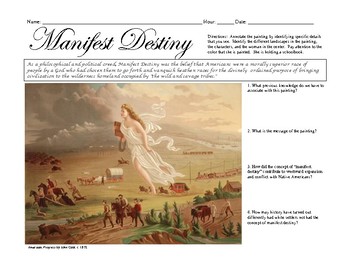Manifest Destiny Painting Analysis Answers: Unveiling History
The painting “Manifest Destiny” depicts American expansionism and its impact on indigenous people. It portrays settlers moving westward, symbolizing the belief in American cultural and territorial superiority.
The artist, John Gast, conveys the idea of destiny and progress through the imagery of civilization replacing wilderness. The painting’s portrayal of indigenous people as passive and inferior reflects the prevailing attitudes of the time. Through its composition and symbolism, “Manifest Destiny” serves as a powerful commentary on the ideology of westward expansion in the 19th century.
The painting captures the fervor and optimism of the era while also raising questions about the cost of progress and the impact on native cultures.
The Concept Of Manifest Destiny
The concept of Manifest Destiny emerged in the 19th century and reflected the belief that the expansion of the United States was both justified and inevitable. It was rooted in the idea that American settlers were destined to expand across the continent, spreading their institutions and culture. This belief had a profound impact on American expansion, driving westward migration and influencing policies that promoted territorial growth. The origins of Manifest Destiny can be traced back to the early colonial period, but it gained prominence during the 1800s as the nation sought to assert its dominance and expand its influence. The painting analysis provides valuable insights into the ideology and motivations behind this significant historical concept.

Manifest Destiny In Art
Manifest Destiny in art is a fascinating subject that explores the visual representation of this significant historical concept. Artists have played a crucial role in capturing the spirit of Manifest Destiny through their works. One notable painting is John Gast’s “American Progress,” which depicts the expansion of American civilization across the West. The painting showcases various symbols of progress, such as the telegraph wire and the locomotive, while Native Americans and wildlife are pushed aside.
Another renowned artist associated with Manifest Destiny is Emanuel Leutze, known for his painting “Westward the Course of Empire Takes Its Way.” This piece portrays the westward movement of American settlers, highlighting the belief in the divine right and duty to expand the nation’s territory.
These artworks not only reflect the mindset of the time but also raise questions about the impact of Manifest Destiny on indigenous populations and the environment. They serve as reminders of the complex history and ideologies that shaped the United States.
Analyzing The Iconic Painting
The Manifest Destiny painting by John Gast is an iconic representation of American progress during the 19th century. The painting portrays various key elements, including an angelic figure, pioneers, a covered wagon, and a telegraph wire. These elements symbolize the belief in American exceptionalism, westward expansion, and progress through technological advancements.
The angelic figure is a representation of divine intervention and the belief that the westward expansion was a God-given mission. The pioneers and covered wagon symbolize the American settlers who ventured westward to fulfill this mission. The telegraph wire represents the progress of technology and communication that enabled the settlers to connect with the rest of the country.
The interpretation of the painting has been a subject of debate, with some seeing it as a glorification of American imperialism and expansionism, while others view it as a representation of American ideals and values. Regardless of the interpretation, the Manifest Destiny painting remains an important piece of American history and culture.

Historical Context And Influence
Manifest Destiny was a belief held by many Americans in the 19th century that the United States was destined to expand across the continent. This concept had a significant impact on both indigenous peoples and territories.
As the United States pushed westward, indigenous peoples were forcibly removed from their lands, leading to the displacement and suffering of countless Native American tribes. Treaties were often broken or ignored, resulting in the loss of ancestral territories and cultural destruction.
The expansion also had a profound effect on the territories themselves. As more land was acquired, the United States experienced rapid economic growth and increased political power. However, this growth came at the expense of the native inhabitants, who were marginalized and pushed further to the fringes of society.
Overall, the Manifest Destiny ideology shaped the course of American history, leaving a lasting legacy of injustice and inequality for indigenous peoples. It serves as a reminder of the complex and often painful consequences of national expansion.
Critical Perspectives
Reevaluation In Modern TimesManifest Destiny, a famous painting depicting the westward expansion of the United States, has been subject to critical perspectives over the years. In contemporary views, the painting is often analyzed from different angles to shed light on the complexities of this historical event. Reevaluation in modern times has led to a deeper understanding of the implications and consequences of Manifest Destiny. It is now acknowledged that the painting, created during a time of nationalistic fervor, presents a biased and idealized version of westward expansion. Contemporary scholars have highlighted the negative impact of Manifest Destiny on Native American tribes and the environment, questioning the notion of American exceptionalism that was celebrated in the painting. By challenging the traditional narrative, these perspectives aim to provide a more balanced and nuanced understanding of this pivotal period in American history. |
Educational Significance
Analyzing the Manifest Destiny painting provides valuable insights into its educational significance. Delving into the painting’s themes and symbols offers answers about American expansionism and its impact on indigenous peoples. Exploring this artwork uncovers historical perspectives that enrich our understanding of this pivotal period in American history.
| Educational Significance |
|---|
| Teaching Manifest Destiny |
Debates And Controversies
Analyzing Manifest Destiny paintings sparks debates and controversies, revealing diverse interpretations and historical perspectives. Unveiling answers through thoughtful examination adds depth to understanding the complex narratives depicted.
| Debates and Controversies |
| Ethical Implications: Analyzing the moral aspects of the painting. |
| Historical Accuracy and Bias: Examining the truthfulness and potential prejudices. |

The Legacy Of Manifest Destiny
The Manifest Destiny painting represents the belief in expansion and growth.
Americans viewed westward expansion as their destiny and right.
This belief shaped American identity and influenced policy decisions.
Conclusion
The analysis of the Manifest Destiny painting provides a deep understanding of its historical significance. The symbolism and artistic techniques used in the painting offer valuable insights into the ideology of westward expansion. By examining the painting in detail, we gain a deeper appreciation of its cultural and historical relevance.





